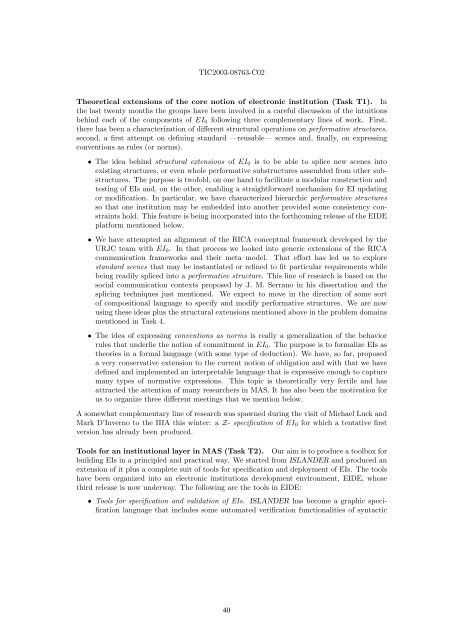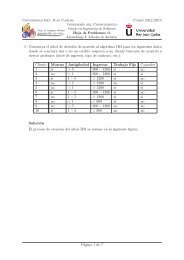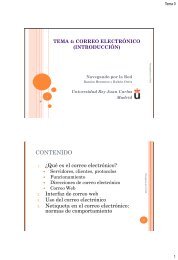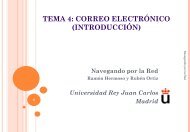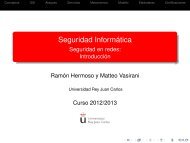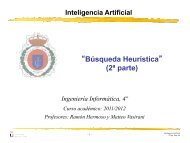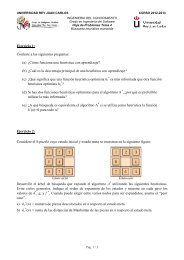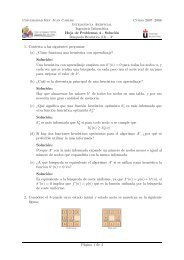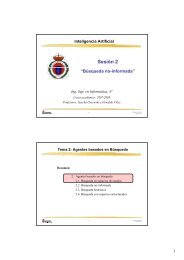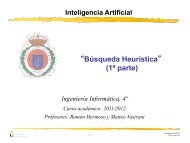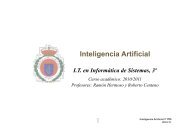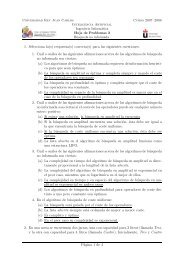GLIRS-II - Grupo de Inteligencia Artificial - Universidad Rey Juan ...
GLIRS-II - Grupo de Inteligencia Artificial - Universidad Rey Juan ...
GLIRS-II - Grupo de Inteligencia Artificial - Universidad Rey Juan ...
You also want an ePaper? Increase the reach of your titles
YUMPU automatically turns print PDFs into web optimized ePapers that Google loves.
TIC2003-08763-C02<br />
Theoretical extensions of the core notion of electronic institution (Task T1). In<br />
the last twenty months the groups have been involved in a careful discussion of the intuitions<br />
behind each of the components of EI0 following three complementary lines of work. First,<br />
there has been a characterization of different structural operations on performative structures,<br />
second, a first attempt on <strong>de</strong>fining standard —reusable— scenes and, finally, on expressing<br />
conventions as rules (or norms).<br />
• The i<strong>de</strong>a behind structural extensions of EI0 is to be able to splice new scenes into<br />
existing structures, or even whole performative substructures assembled from other substructures.<br />
The purpose is twofold, on one hand to facilitate a modular construction and<br />
testing of EIs and, on the other, enabling a straightforward mechanism for EI updating<br />
or modification. In particular, we have characterized hierarchic performative structures<br />
so that one institution may be embed<strong>de</strong>d into another provi<strong>de</strong>d some consistency constraints<br />
hold. This feature is being incorporated into the forthcoming release of the EIDE<br />
platform mentioned below.<br />
• We have attempted an alignment of the RICA conceptual framework <strong>de</strong>veloped by the<br />
URJC team with EI0. In that process we looked into generic extensions of the RICA<br />
communication frameworks and their meta–mo<strong>de</strong>l. That effort has led us to explore<br />
standard scenes that may be instantiated or refined to fit particular requirements while<br />
being readily spliced into a performative structure. This line of research is based on the<br />
social communication contexts proposed by J. M. Serrano in his dissertation and the<br />
splicing techniques just mentioned. We expect to move in the direction of some sort<br />
of compositional language to specify and modify performative structures. We are now<br />
using these i<strong>de</strong>as plus the structural extensions mentioned above in the problem domains<br />
mentioned in Task 4.<br />
• The i<strong>de</strong>a of expressing conventions as norms is really a generalization of the behavior<br />
rules that un<strong>de</strong>rlie the notion of commitment in EI0. The purpose is to formalize EIs as<br />
theories in a formal language (with some type of <strong>de</strong>duction). We have, so far, proposed<br />
a very conservative extension to the current notion of obligation and with that we have<br />
<strong>de</strong>fined and implemented an interpretable language that is expressive enough to capture<br />
many types of normative expressions. This topic is theoretically very fertile and has<br />
attracted the attention of many researchers in MAS. It has also been the motivation for<br />
us to organize three different meetings that we mention below.<br />
A somewhat complementary line of research was spawned during the visit of Michael Luck and<br />
Mark D’Inverno to the <strong>II</strong>IA this winter: a Z- specification of EI0 for which a tentative first<br />
version has already been produced.<br />
Tools for an institutional layer in MAS (Task T2). Our aim is to produce a toolbox for<br />
building EIs in a principled and practical way. We started from ISLANDER and produced an<br />
extension of it plus a complete suit of tools for specification and <strong>de</strong>ployment of EIs. The tools<br />
have been organized into an electronic institutions <strong>de</strong>velopment environment, EIDE, whose<br />
third release is now un<strong>de</strong>rway. The following are the tools in EIDE:<br />
• Tools for specification and validation of EIs. ISLANDER has become a graphic specification<br />
language that inclu<strong>de</strong>s some automated verification functionalities of syntactic<br />
40


